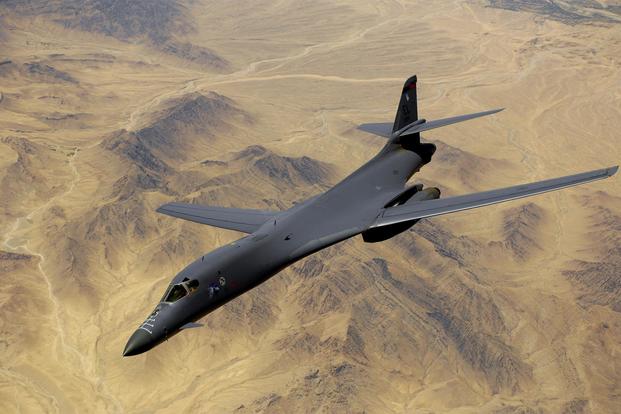B-1B Lancer bombers landed at an air base in Saudi Arabia this week, marking a surprise return of the long-range bombers to the Middle East after they were pulled early this year.
A series of videos from U.S. Air Forces Central Command and Air Force Global Strike Command posted on social media Friday showed the bombers taking off from Ellsworth Air Force Base, South Dakota -- home of the 28th Bomb Wing -- and landing at Prince Sultan Air Base.
The service did not disclose how many of the non-nuclear bombers were sent, nor the duration of the aircrafts’ deployment. Additional details were not provided by press time.
Earlier this month, the Defense Department signed off on a plan to send thousands more troops to act as a force stabilizer in response to Iran's continued antagonistic actions in the Middle East. The U.S. forces deployed with two fighter squadrons, an Air Expeditionary Wing, two Patriot missile batteries, and one Terminal High Altitude Area Defense system, known as THAAD. The Pentagon did not previously disclose the bombers’ presence.
Related: With B-1 Aging and B-21 Still Years Out, Air Force May Soon Have No Go-To Bomber
The Saudi air base has seen significant buildup from U.S. troops in recent months in response to Iranian provocations. Defense Secretary Mark Esper this week toured the base, and was seen standing in front of the missile battery as well as a number of F-22 Raptors from the 27th Expeditionary Fighter Squadron Joint Base Langley-Eustis, Virginia, according to Air Force Magazine.
The additive "Bone" deployment comes as the fleet has undergone extensive maintenance to keep the heavy bomber ready.
The variable-sweep wing aircraft left the Middle East in early 2016, the first time it would be called back from forward operations for a major upgrade to its avionics suite. Air Force officials at the time said the B-1B's return to the U.S. was crucial in order to upgrade the fleet with the latest Integrated Battle Station, or IBS.
The B-1s went back to the Middle East in 2018, but returned a few months later in early 2019. In that timeframe, officials first grounded the fleet over a problem related to the Lancer's ejection seat sequence system.
Upon their return in March, the bombers were again grounded due to an egress issue. The 62 bombers in the fleet underwent a careful inspection process, and one by one, B-1s returned to flightlines in April.
Despite the setbacks, AFGSC commander Gen. Tim Ray said he’s willing to exercise the bomber fleet -- to include the B-52 Stratofortress and B-2 Spirit -- with shorter, weeks-long deployments to test aircrews’ agility.
In March, the command deployed the B-52 as part of a “Bomber Task Force” to RAF Fairford, England for a month-long rotation, not uncommon for the European theater, which has had a bomber rotation at least once a year since Russia's 2014 annexation of Crimea.
B-52s deployed to England again earlier this month, and trained with counterparts in Romania, Ukraine and Georgia along the Black Sea.
Ray said the practice is not meant to be limited to Europe.
"We're going to go to Central Command, we're going to go to the Pacific. We're going to go to lots of places," he told reporters in April at a Defense Writers Group breakfast.
"[With] these dynamic employments... airmen come back more ready, more relevant for the future fight," Ray added during a recent interview with Military.com. "I see these as an exceptionally wise approach."
He added he doesn't believe the missions will keep aircraft fleets, like the B-1, from undergoing maintenance.
"[The deployments are] short, they're crisp, they're not long and enduring. [And] there's something that's really important for everybody to understand -- there are no ally bombers. This is one thing that we do better than anybody else," he said.
-- Oriana Pawlyk can be reached at oriana.pawlyk@military.com. Follow her on Twitter at @Oriana0214.












